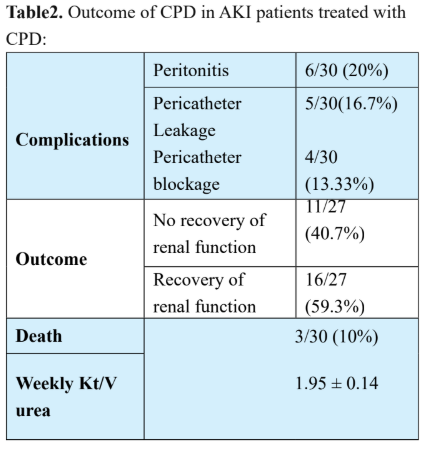Abstract
Background:
Though peritoneal dialysis has several
limitations, it is still used in acute kidney injury (AKI)
patients as an alternative method of Renal Replacement
Therapy (RRT), especially in low socioeconomic
countries.
Materials and Method:
This study included thirty patients diagnosed as AKI.
Peritoneal accesswas established through flexible Tenckhoff catheter for
Continuous Peritoneal Dialysis (CPD) and 6-8 exchanges
were done in 24 hours.
Results: Among 30 patients mean
age was (mean±SD) 49.93±14.42 years. Seven (23.33%)
patients were hemodynamically unstable. The cause of
AKI was drug induced in 6(20.7%), hypovolemia/Acute
Tubular Necrosis in 6(20.0%), sepsis in 5(16.7%), heart
failure in 2(6.7%) and 11(36.7%) had multiple causes.
In initial presentation, mean serum creatinine was
683.42 μmol/L, and the number of sessions required for
stabilization of serum creatinine was 7.5±1.43, sessions
required for correction of hyperkalemia and metabolic
acidosis were 2.15±0.69 and 2.5±0.76 respectively. The
delivered Kt/V urea was 1.95±0.14 weekly. Six (20.0%)
patients had peritonitis, five (16.7%) had pericatheter
leakage and four (13.33%) had catheter blockage. Among
30 patients, three patients (10%) had died, sixteen (59.3%)
had recovery of renal function and rest did not recover
renal function.
Conclusion: CPD was effective for
correction of metabolic and electrolyte imbalance.
References
failure. Benner & Rector’s the Kidney. 6th ed. 2000;
1201-62.
2. George J, Varma S, Kumar S, Thomas J, Gopi S,
Pisharody R: Comparing continuous venovenous
hemodiafiltration and peritoneal dialysis in
critically ill patients with acute kidney injury: a
pilot study. Perit Dial Int 2011; 31:422–9
3. Gabriel DP, Nascimento GV, Caramori JT, Martim
LC, Barretti P, Balbi AL. Peritoneal dialysis in acute
renal failure. Peritoneal Dialysis International. 2006;
28: 451–56.
4. Scott D. Bieber, John Burkart, Thomas A. Golper,
Isaac Teitelbaum, Melhotra R, et al. Comparative
Outcomes Between Continuous Ambulatory and
Automated Peritoneal Dialysis: A Narrative Review.
AJKD 2014:63: 6: 1027–1037.
5. Phu NH, Hien TT, Mai NTH et al. Hemofiltration
and peritoneal dialysis in infection associated acute
renal failure in Vietnam. New England Journal of
Medicine, 2002; 347: 895–902.
6. Bazari H. Hemofiltration and peritoneal dialysis
in infection-associated acute renal failure. New
England Journal of Medicine 2003; 348:858–60.
7. Ponce D, Marina Nogueira Berbel, Cassiana Regina
de Goes, Cibele Taís Puato Almeida, André Luís
Balbi. High-Volume Peritoneal Dialysis in Acute
Kidney Injury: Indications and Limitations. CJASN
June 07, 2012; vol. 7 no. 6 887-894
Cibele Puato Almeida, Daniela Ponce, Ana
Carolina de Marchi, Andre Luis Balbi et al. Effect
of Peritoneal Dialysis on Respiratory Mechanics in
Acute Kidney Injury Patients. Perit Dial Int July-
August 2014 34:544-549.
9. Chitalia VC, Almeida AF, Rai H et al. Is peritoneal
dialysis adequate for hypercatabolic acute renal
failure in developing countries? Kidney International
2002; 61(2): 747–57.
10. Brett Cullis, Mohamed Abdelraheem, Georgi
Abrahams, Andre Balbi, et al. Peritoneal Dialysis
for Acute Kidney Injury. Perit Dial Int 2014:34: 5:
494-517
11. Kajiru Gad Kilonzo, Sudakshina Ghosh, Siya
Anaeli Temu, Venance Maro et al. Outcome of Acute
Peritoneal Dialysis in Northern Tanzania. Perit Dial
Int May-June 2012 32:261-266.
12. M Leblanc, D Ouimet et al. Dialysate leaks
in peritoneal Dialysis. Semin Dial 2001 Jan-
Feb;14(1):50-4
13. Chionh CY, Ronco C, Finkelstein FO, Soni SS, Cruz
DN. Use of peritoneal dialysis in AKI: a systematic
review. Clinical Journal of American Society of
Nephrology. 2013; 8(10): 1649–60

